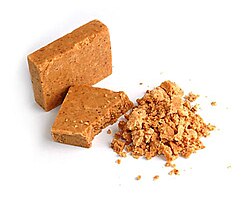User:Antonio.rivero/sandbox
 Industrialized paçoca chips. | |
| Place of origin | Brazil |
|---|---|
| Region or state | Rio de Janeiro |
| Main ingredients | Ground peanuts, sugar |

- This article is about the brazilian candy. For the salty dish, see Paçoca(salty dish)
Paçoca (Portuguese: [pɐˈsɔkɐ]) is a Brazilian candy made out of ground peanuts, cassava flour, sugar and salt. It is typical of the Caipira cuisine and most present in the interior of southeastern states of São Paulo and Minas Gerais, being either manufactured or home-made. It is also very common during the Festa Junina, an annual festivity that celebrates the caipira lifestyle. It is known for its distinct dry texture and sweet taste, and is one of the most beloved brasilian candies.[1]
Origins[edit]
- The Paçoca in its present form has only been has been invented during the Colonial Brazil Period, but Native Brazilian peoples had recipes that mixed cassava flour with other ingredients prior to the colonization. Those recipes were modified by the settlers creating the current combination that uses sugar.[1]
Name and relationship to the salty dish[edit]
- The name "paçoca" comes from the Tupi word "posok" (pronounced /pɔsɔk/) which means "to crumble" or "to shatter", and is shared with the salty Paçoca dish. Both are a mix of cassava flour with other ingredients: peanut and sugar in the case of the sweet, and carne-de-sol(sun-dried-beef) for the salty dish. Both dishes seem to be originated from the same Native Brazilian costumes, but have grown to be completelly different products
Production[edit]
- The traditional artesanal process of making paçoca involves firstly roasting the peanuts, then a traditional Mortar(pilão) was used to grind together the all the ingredients.[2] In more modern manufacturing techniques instead of a mortar, industrial blenders are used, and the Paçocas are later pressed onto many shapes, most commonly square or cork shapes.
Variations[edit]
- Some companies have created variations from the traditional Paçoca recipe, which include a diet version, with no sugar added, and a higher peanut concentration.[2]

